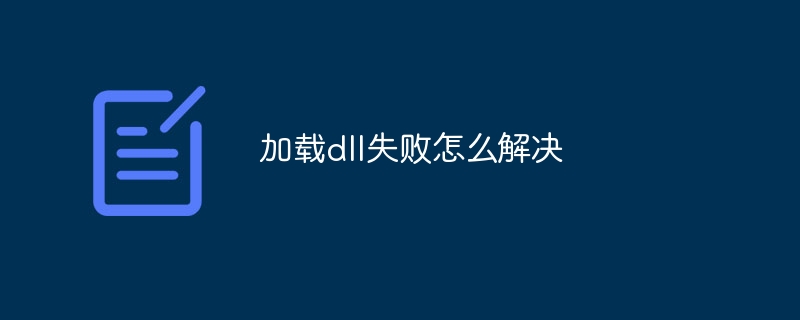
The solution to failure to load dll is to first check whether the DLL file exists, check whether the DLL file is complete, check the dependencies of the DLL file, ensure that the correct DLL version is used, check the access permissions of the DLL file, and confirm Match the bitness of the operating system to the bitness of the DLL file, check environment variables and path settings, check compilation options and link settings, use appropriate load functions, use debugging tools for troubleshooting, etc. Detailed introduction: 1. Check whether the DLL file exists. First, make sure that the DLL file to be loaded exists in the specified path, etc.

#When loading a DLL (dynamic link library) in a program and encountering a loading failure, the application may not run properly. The following are some common solutions to help you solve the problem of failed loading of DLL:
1. Check whether the DLL file exists:
First, make sure that the DLL file to be loaded exists in the specified path middle. Check that the file name, path and file extension are correct. If the DLL file does not exist, you need to re-obtain or install the correct DLL file.
2. Check whether the DLL file is complete:
If the DLL file is damaged or incomplete, the loading process may fail. Make sure the DLL file is intact, either by re-downloading it or by obtaining the DLL file from a reliable source.
3. Check the dependencies of the DLL file:
The DLL file may depend on other DLL files or system components. If a dependent DLL file or system component is missing, loading the DLL file will fail. You can use tools such as Dependency Walker to check the dependencies of a DLL file and ensure that all dependencies are available.
4. Make sure you are using the correct DLL version:
There are different versions of DLL files, and different applications may require specific versions of DLL files. Make sure to use the correct version of the DLL file that is compatible with your application. You can check the application's documentation or contact the provider of the DLL file to obtain the correct version.
5. Check the access permissions of the DLL file:
Make sure the access permissions of the DLL file are set correctly so that the application can read and execute the DLL file. Check the read permissions, execution permissions of the file and the permission settings of the directory where it is located.
6. Confirm that the bitness of the operating system matches the bitness of the DLL file:
The DLL file may have 32-bit and 64-bit versions. Make sure that the bitness of the operating system matches the bitness of the DLL file. Number matches. If the operating system is 32-bit, you need to use a 32-bit DLL file; if the operating system is 64-bit, you need to use a 64-bit DLL file.
7. Check the environment variables and path settings:
Ensure that the system's environment variables and path settings are correct so that the application can correctly find the DLL file. You can check the system's PATH environment variable to make sure it contains the path where the DLL file is located.
8. Check the compilation options and link settings:
If you are a developer, you can check the compilation options and link settings of your application. Make sure the DLL file is referenced and linked correctly during compilation and linking.
9. Use the appropriate loading function:
When loading the DLL file in the program, you can use the appropriate loading function. In Windows systems, commonly used loading functions include LoadLibrary, LoadLibraryEx, GetProcAddress, etc. Choose the appropriate load function for your needs and make sure it is used correctly.
10. Use debugging tools for troubleshooting:
If the above methods still cannot solve the problem of failure to load the DLL, you can use debugging tools for troubleshooting. You can use the debugger to trace the loading process and view associated error messages and call stacks. This can help you find the reason why the load failed.
If you encounter problems loading DLL files, the above are some common solutions. Depending on the situation, you may need to try one or more of these methods to resolve the issue. If the problem persists, it is recommended to consult the relevant documentation, seek help from the developer community, or contact the provider of the DLL file for support.
The above is the detailed content of How to solve the problem of failure to load dll. For more information, please follow other related articles on the PHP Chinese website!




